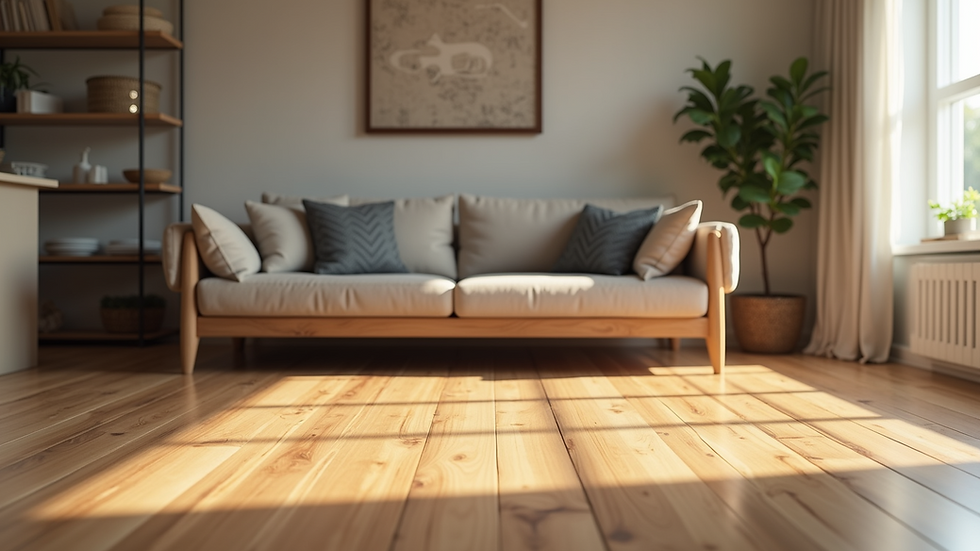Wood floor insects: fast ID, fixes, and prevention 🪵
- Riley Thorne

- Sep 8
- 3 min read
If you’re seeing pinholes, dust, or soft spots, you’re likely dealing with wood floor insects. This quick homeowner guide explains how to identify the usual suspects, what to do first, and how to keep wooden floor insects (a.k.a. wood floor bugs) from returning—without damaging your floors or finishes. 🐜
Pro tip: Before you treat, confirm moisture. Most infestations track excess humidity or leaks. A $20–$40 pinless moisture meter can save you from chasing the wrong problem.

Wood floor insects: quick ID and first steps
Not all damage comes from the same pest. Match the sign to the likely culprit, then act methodically (dry the area, isolate, treat, and monitor).
Likely pest | What you’ll see on floors | How to confirm | First move | When to call a pro |
Powderpost beetles | Tiny round pinholes, fine talc-like frass piles | Fresh frass reappears after vacuuming; holes cluster with the grain | Lower moisture (<12%), isolate boards; consider borate treatment on bare wood | Large active areas or finished floors you can’t strip |
Termites (subterranean) | Rippled or sunken spots; mud tubes on foundation/walls | Spring swarmers (winged), soft subfloor at joists | Fix moisture, break soil-wood contact, inspect structure | Any structural signs—get a licensed inspection |
Carpenter ants | Rustling in voids; small piles of coarse sawdust | Night activity near moisture sources; trails from entry points | Correct leaks, improve ventilation; bait/target nest | If activity persists or nest is inaccessible |
Wood-boring weevils | Fine holes in damp, previously damaged wood | High moisture in crawl/basement; slow, ongoing powder | Aggressive drying; replace worst sections | If moisture is corrected but frass continues |
House longhorn beetle (rare indoors) | Larger oval exit holes; audible larval chewing | Often tied to softwood framing near heat | Confirm species; targeted professional treatment | Always—can be structural |
Field note: Fresh frass looks fluffy and returns after cleanup. Old, compacted dust usually means historic (inactive) damage.
Action plan that protects the floor (and your budget)
Find and fix moisture. Dehumidify basements/crawlspaces, repair plumbing leaks, and improve subfloor ventilation. Most wood floor bugs need elevated moisture to thrive.
Map the damage. Tape a clear plastic card over a suspect area and check for new frass in 48–72 hours. Mark dates—documenting activity guides decisions.
Choose the least invasive treatment.
Powderpost beetles: If the finish is permeable or boards are bare, borate penetrants can stop active larvae. If the floor has a hard film finish, spot replacement may be smarter than stripping a whole room.
Termites/carpenter ants: Address moisture and access first (soil-wood contact, foam-in-place gaps, wet sills). Then consider targeted professional treatments.
Replace what can’t be saved. Isolated, heavily bored boards are better replaced than endlessly patched.
Verify success. No new frass, no fresh pinholes, and moisture back in the safe range for several weeks.
Pro tip: If you must lift boards, label the sequence and room orientation. Re-laying in the same order preserves your pattern and minimizes sanding.
Prevention that actually works
Keep hardwood at 30–50% RH. Seasonal swings beyond that invite movement and pests.
Seal entry points below. Screen crawlspace vents properly; close gaps at sill plates and pipe penetrations.
Finish smart. Film finishes block borate penetration later; for kitchens/baths over crawlspaces, consider breathable finishes + strict humidity control.
Mind secondhand lumber or décor. Bake or quarantine reclaimed pieces; hidden larvae can hitchhike into finished rooms.
Inspect seasonally. Corners, under rugs, and along exterior walls are the first to show trouble.
FAQ
In one sentence: how do I deal with wood floor insects?Confirm the pest and moisture source, dry the area, apply the least invasive targeted treatment, replace unsalvageable boards, and monitor for new frass.
Are “wooden floor insects” and “wood floor bugs” the same issue?Yes—both terms refer to pests that bore, nest, or feed in wood flooring and subfloor assemblies.
Do I need to tent/fumigate for beetles?Rarely for finished floors; targeted moisture correction and borate (where penetrable) or board replacement usually solve active, localized issues.
What if the damage keeps spreading?Recheck humidity and structure (subfloor/joists). Ongoing activity after drying often points to a missed moisture source—or the wrong pest diagnosis.
Treat the cause, not just the holes. Dry the assembly and you cut off the lifecycle that created the damage.”
Fresh frass = active. No new powder for weeks usually means historic damage you can patch during the next refinish.”
Conclusion
When you know the signs, wood floor insects are manageable. Start with moisture control, confirm activity (don’t chase old damage), then select treatments that respect your finish. With that approach, wooden floor insects and other wood floor bugs become a short project—not a recurring headache.



Comments